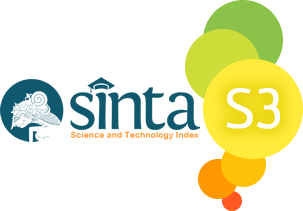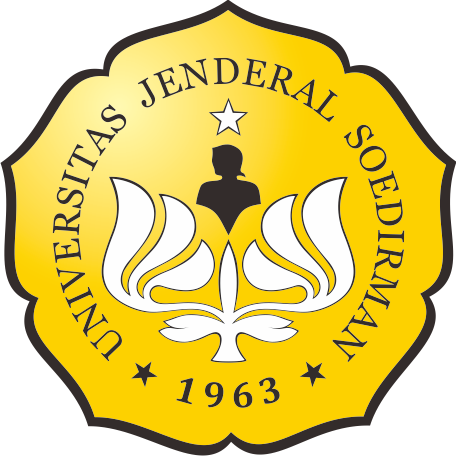METODE EKSTRAKSI DNA CABAI (Capsicum annuum L.) MENGGUNAKAN MODIFIKASI BUFFER CTAB (CETHYL TRIMETHYL AMMONIUM BROMIDE) TANPA NITROGEN CAIR
Abstrak
Chili pepper is an agricultural commodity having high economic value. The production and supply of chili pepper frequently did not match the increased demand; it caused the market price fluctuated. It is important to create new varieties of chili pepper with high production trait to overcome the scarcity. Therefore the plant breeding activities for chili pepper should be done intensively in both conventional and molecular-based to obtain varieties of chili pepper with expected qualities. In molecular breeding, DNA extraction is the crucial steps of the process. If extracted DNA has an excellent quality and quantity, the next processes normally could be completed with the high-quality result. To date, most methods of DNA extraction used liquid nitrogen to destroy the tough carbohydrates of plant tissue. Liquid nitrogen is nitrogen gas in a fluid state which quite difficult to be distributed to the remote laboratory wit no available storage facility. This study aimed to obtain a modified DNA extraction method, in particular for chili pepper, which capable to produce DNA with high quality and quantity without using liquid nitrogen. The sample used consisted of eight F2 plants including their hybrid-parental of the Kencana and the 0207. This research applied modified Doyle and Doyle method for extraction. Modification of extraction buffer is done through the addition of the 1% (w/v) PVP (Polyvinylpyrrolidone) and 0.2% (v/v) β-mercaptoethanol. The results showed that the DNA extracted using this method has good quality and quantity, capable of being amplified by using SSR (Simple Sequence Repeat) primer and could be digested by restriction enzyme EcoRI. Besides, this method can reduce dependence on the use of liquid nitrogen, in particular for remote laboratories with no available storage facility.
Kata Kunci
Teks Lengkap:
PDFReferensi
Ahmed I, Islam M, Arshad W, Mannan A, Ahmad W, Mirza B. 2009. High–quality plant DNA extraction for PCR: an easy approach. J Appl Genet 50(2):105–107. https://doi.org/10.1007/BF03195661
Bintang M. 2010. Biokimia Teknik Penelitian.Jakarta:Penerbit Erlangga.
Chi MH, Park SY, Lee YH. 2009. A quick and safe method for fungal DNA extraction. Plant Pathol. J. 25(1):108–111. https://doi.org/10.5423/PPJ.2009.25.1.108
Dhakshanamoorthy D, Selvaraj R. 2009. Extraction of genomic DNA from Jatropha sp. using modified CTAB method. Rom. J. Biol. Plant. Biol. 54(2):117–125.
Doyle JJ, Doyle JL. 1990. Isolation of plant DNA from fresh tissue. Focus 12:13–15.
Fang G, Hammar S, Grumet R. 1992. A quick and inexpensive method for removing polysaccharides from plant genomic DNA. Biotechniques.13:52–54.
Fulton TM, Chunwongse J, Tanksley SD. 1995. Microprep protocol of extraction DNA from tomato and other herbaceous plants. Plant Molecular Biology Reporter. 13(3):207–209. https://doi.org/10.1007/BF02670897
Hoarau G, Coyer JA, Stam WT, Olsen JL. 2007. A fast and inexpensive DNA extraction/purification protocol for brown macroalgae. Molecular Ecology Notes 7:191–193. https://doi.org/10.1111/j.1471-8286.2006.01587.x
Healey A, Furtado A, Cooper A, Henry RA. 2014. Protocol: a simple method for extracting next–generation sequencing quality genomic DNA from recalcitrant plant species. Plant Methods 10:21. https://doi.org/10.1186/1746-4811-10-21
Ibrahim RIH. 2010. A modified CTAB protocol for DNA extraction from young flower petals of some medicinal plant species. Geneconserve 10(40):165–182.
Irawan B. 2007. Fluktuasi harga, transmisi harga dan marjin pemasaran sayuran dan buah. Analisis Kebijakan Pertanian 5 (4):358–373
Kapa Biosystems. 2014. KAPA2G Fast HotStart PCR Kit Technical Data Sheet [internet]. Kapa Biosystems Inc., Wilmington, MA. [cited 2017 May 12]. Available from: https://www.kapabiosystems.com/assets/KAPA2G_Fast_HotStart_TDS.pdf
Križman M, Jakše J, Baričevič D, Javornik B, Prošek M. 2006. Robust CTAB–activated charcoal protocol for plant DNA extraction. Acta agriculturae Slovenica 87(2): 427–433.
Li JT, Yang J, Chen DC, Zhang XL, Tang ZA. 2007. An optimized mini–preparation method to obtain high–quality genomic DNA from mature leaves of sunflower. Genet. Mol. Res. 6 (4):1064–1071.
Lodhi MA, Ye GN, Weeden NF, Reisch BI. 1994. A simple and efficient method for DNA extraction from grapevine cultivars, Vitis species and Ampelopsis.Plant Molecular Biology Reporter 12(1):6–13. https://doi.org/10.1007/BF02668658
Mӧller EM, Bahnweg G, Sandermann H, Geiger HH. 1992. A simple and efficient protocol for isolation of high molecular weight DNAfrom filamentous fungi, fruit bodies, and infected plant tissues. Nucleic Acids Researchv 20(22):6115–6116. https://doi.org/10.1093/nar/20.22.6115
Mornkham T, Wangsomnuk PP, Wangsomnuk P, Jogloy S, Pattanothai A, Fu YB. 2012. Comparison of five DNA extraction methods for molecular analysis of Jerusalem artichoke (Helianthus tuberosus). Genetics and Molecular Research 11(1):572–581. https://doi.org/10.4238/2012.March.8.5
Ogunkanmi AL, Oboh B, Onifade B, Ogunjobi AA, Taiwo IA, Ogundipe OT. 2008 An improved method of extracting genomic DNA from preserved tissues of Capsicum annuum for PCR amplification. EurAsia J BioSci 2:115–119.
Prince JP, Zhang Y, Radwanski ER, Kyle EM. 1997. A versatile and high–yielding protocol for the preparation of genomic DNA from Capsicum spp. (Pepper). HortScience 32 (5):937–939.
Sahu SK, Thangaraj M, Kathiresan K. 2012. DNA extraction protocol for plants with high levels of secondary metabolites and polysaccharides without using liquid nitrogen and phenol. ISRN Molecular Biology 2012:1–6. https://doi.org/10.5402/2012/205049
Shankar K, Chavan L, Shinde S, Patil B. 2011. An improved DNA extraction protocol from four in vitro banana cultivars. Asian Journal of Biotechnology 3(1):84–90. https://doi.org/10.3923/ajbkr.2011.84.90
Sharma K, Mishra AK, Misra RS. 2008. A simple and efficient method for extraction of genomic DNA from tropical tuber crops.Afr. J. Biotechnol 7(8):1018–1022.
Sharma P, Joshi N, Sharma A. 2010. Isolation of genomic DNA from medicinal plants without liquid nitrogen. Indian J. Exp. Biol. 48:610–614.
Singh V, Kumar V. 2012. An optimized method of DNA isolation from highly mucilage–rich okra (Abelmoschus Esculentus L.) for PCR analysis.Adv. Appl. Sci. Res. 3(3):1809–1813.
Syamkumar S, Lowarence B,Sasikumar, B. 2003.Isolation and Amplification of DNA fromrhizomes of turmeric and ginger. Plant Molecular Biology Reporter. 21:171a–171e. https://doi.org/10.1007/BF02774243
Syukur M, Sujiprihati S, Yunianti R, Kusumah DA. 2010. Evaluasi daya hasil cabai hibrida dan daya adaptasinya di empat lokasi dalam dua tahun. J.Agron. Indonesia 38(1):43–51.
ThermoScientific. 2011. Assessment of Nucleic Acid Purity, T042‐Technical BulletinNanoDrop Spectrophotometers [internet]. Thermo Fisher Scientific Waltham, MA [cited 2017 May 12]. Available from http://www.nanodrop.com/Library/T042–NanoDrop–Spectrophotometers–Nucleic–Acid–Purity–Ratios.pdf.
Varma A, Padh H, Shrivastava N. 2007. Plant genomic DNA isolation: an art or a science. Biotechnol. J. 2:386–392. https://doi.org/10.1002/biot.200600195
Ying ST, Zaman FQ. 2006. DNA extraction from mature oil palm leaves. Journal of Oil Palm Research 18:219–224.
Zidani S, Ferchichi A, Chaieb M. 2005. Genomic DNA extraction method from pearl millet (Pennisetum glaucum) leaves. Afr. J. Biotechnol. 4 (8):862–866.
Article Reads
Total: 20760 Abstrak: 7424 PDF: 13336Refbacks
- Saat ini tidak ada refbacks.

This work is licensed under a Creative Commons Attribution-ShareAlike 4.0 International License.
This website is maintained by:
Bio Publisher
The Faculty of Biology Publishing
Laman ini dikelola oleh:
Penerbitan Fakultas Biologi
Universitas Jenderal Soedirman
Jalan dr. Suparno 63 Grendeng
Purwokerto 53122
Telepon: +62-281-625865
Email: biologi@unsoed.ac.id
Laman ini menggunakan:
OJS | Open Journal System
Software pengelolaan jurnal ilmiah online. Versi yang digunakan adalah 2.4.8.0.
Metadata artikel terdaftar di:
Crossref
Agen resmi internasional pendaftaran Digital Object Identifier (DOI)
Artikel jurnal ini terindeks:








